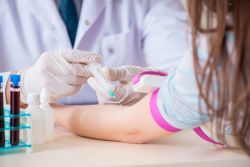Diagnosing Latex Allergy
A latex allergy should be suspected in anyone who develops symptoms after latex exposure.
Any exposed worker who experiences the known symptoms should be evaluated by a physician as soon as possible. Further exposure could result in a serious allergic reaction.
Taking a complete medical history is the first step in diagnosing a latex allergy. Blood tests approved by the Food and Drug Administration (FDA) are available to detect latex antibodies.
Testing is also available to diagnose allergic contact dermatitis. In this FDA-approved test, a special patch containing latex additives is applied to the skin and checked over several days. A positive reaction is shown by itching, redness, swelling, or blistering where the patch covered the skin.
In some cases, tests may fail to confirm a worker who has a true allergy to latex. In other instances, tests may suggest latex allergy in a worker with no clinical symptoms. Therefore, test results must be evaluated by a knowledgeable physician.
Knowledge Check Choose the best answer for the question.
1-5. What is listed as the first step in diagnosing a latex allergy?
You forgot to answer the question!

